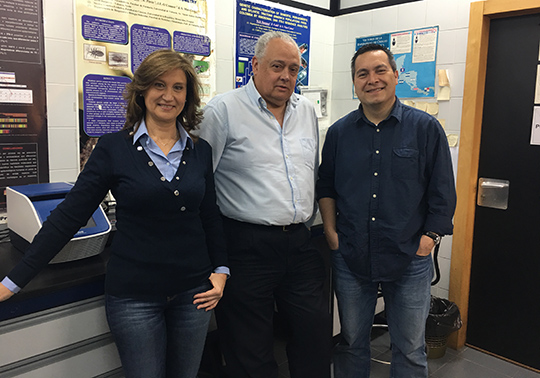Scientifics of the Universitat de València determine the origin and expansion of the human fascioliasis in South America
- April 7th, 2017

The Unit of Human Parasitology of the Universitat de València in collaboration with Uruguayan researchers have determined the origin and expansion of fascioliasis in South America. This is an emerging disease that affects 17 million people with a great risk of expansion. By a molecular analysis, the team has proved that the vector of the disease (specie that passes it on, in this case a type of snail of fresh water) is different in the Andean regions. The research is part of the WHO global initiative against human fascioliasis and it has been published in the journal ‘PLOS Neglected Tropical Diseases’.
“The fascioliasis is an emerging disease that can cause death in humans and high loss of herd. This is an illness that cause the subdevelopment of the affected communities and it is related to the climate change, that currently is spreading geographically and the herd is its reservoir”, explains Santiago Mas-Coma, full university professor of Parasitology of the Universitat de València, expert in parasitic diseases at the World Health Organisation (WHO); and coordinator of the group WHO/FAO/United Nations of the academic institution.
The main contribution of the research is that the vector specie, in this case the snail that passes on the disease in South America, is different in the high Andean zones (Galba truncatula) such as Bolivia and Peru, and in the lowland areas (Lymnaea neotropica) such as Uruguay, where this illness hardly affects humans. “Furthermore, the group has elucidated the origin of the disease in Uruguay. This is the consequence of the introduction of the parasite and the vector by the management of the herd by Spanish people in the first years of colonisation when there was a silver transport from Potosi mines in Bolivia”, adds Mas-Coma.
María Dolores Bargues, full university professor of Parasitology of the Universitat de València, has developed the molecular studies of the research. “It has been a difficult labour of sequencing of the parasite and its vectors. Many years ago, we developed some DNA markers that nowadays have allow us to analyse the traceability of the disease in the past and its correlation with the beginnings of the Spanish colonisation in the époque of the Viceroyalty of the Río de la Plata that comprised from Buenos Aires to Alto Peru. It was very exciting to verify how the molecular data was progressively drawing a dispersion of the disease that fitted to the history of colonisation”, has emphasised.
The work has been carried out in collaboration with the División de Laboratorios Veterinarios Miguel C. Rubino (DILAVE) of the Ministry of Agriculture, Livestock, and Fisheries of Uruguay. The project has been funded for the whole Latin America by the International Agency of Atomic Energy, coordinated by Gerrit Viljoen, of the central HQ of this organisation in Vienna. And it is part of the programme of the World Health Organisation to eradicate the human fascioliasis. In the research, apart from Mas-Comas and Bargues, Patricio Artigas, researcher of the Pharmacy, has also taken part.
Valeria Gayo, veterinarian in charge of the endoparasites of the DILAVE, has coordinated the project of IAEA in Latino America. The deep knowledge of this expert in fascioliasis in Uruguay has been essential. In Uruguay, the available information about the herd and its history is superior to the rest of American countries. “This basis of knowledge, the contributions of Gayo and more Uruguayan experts have been crucial for a study whose results reveal that there is no serious risk of human infection and that the main vector in the country is different from what have been thought”, says Mas-Coma.
“Despite working more than 25 years about this disease in Bolivia, Peru and other Andean countries, a non-Andean country like Uruguay has allow such significant progress for America. This is a wonderful example of the importance of the international scientific collaboration and also the so-called collaboration south-south”, concludes the full university professor of Parasitology of the Universitat de València.
Article:
Bargues MD, Gayo V, Sanchis J, Artigas P, Khoubbane M, et al. (2017) «DNA multigene characterization of Fasciola hepatica and Lymnaea neotropica and its fascioliasis transmission capacity in Uruguay, with historical correlation, human report review and infection risk analysis». PLOS Neglected Tropical Diseases 11(2): e0005352. doi: 10.1371/journal.pntd.0005352
















